The Railway Window Market is estimated to be valued at USD 464.4 million in 2025 and is projected to reach USD 714.4 million by 2035, registering a compound annual growth rate (CAGR) of 4.4% over the forecast period.
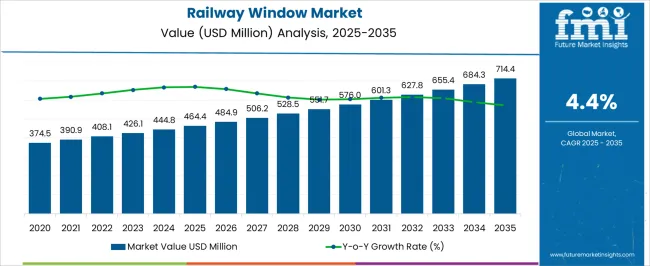
| Metric | Value |
|---|---|
| Railway Window Market Estimated Value in (2025 E) | USD 464.4 million |
| Railway Window Market Forecast Value in (2035 F) | USD 714.4 million |
| Forecast CAGR (2025 to 2035) | 4.4% |
The Railway Window market is undergoing notable transformation, supported by the ongoing evolution of passenger rail services and the increasing focus on enhanced travel comfort, safety, and energy efficiency. Global investment in railway infrastructure, modernization of rolling stock, and refurbishment programs for existing coaches have significantly contributed to the rising demand for high-performance window systems.
Enhanced passenger expectations for aesthetics, thermal insulation, and noise reduction are driving the adoption of advanced window solutions. Press statements from rail equipment manufacturers and updates from national rail operators have emphasized the importance of durable and maintenance-friendly components, creating favorable conditions for long-term growth.
Additionally, regulatory standards concerning passenger safety and environmental sustainability are reinforcing the shift toward lightweight and energy-efficient window technologies These trends, combined with continued urbanization and expansion of mass transit systems across emerging economies, are expected to provide steady momentum to the Railway Window market over the coming years.
The market is segmented by Type, Product Type, Technology, and Train Type and region. By Type, the market is divided into Side Window, Windshield Window, and Others. In terms of Product Type, the market is classified into Sliding Window, Fixed Window, and Others. Based on Technology, the market is segmented into Conventional Railway Windows, Smart Railway Windows, and Others. By Train Type, the market is divided into Subway or Metro Trains, Regular Passenger Trains, High Speed or Bullet Trains, and Others. Regionally, the market is classified into North America, Latin America, Western Europe, Eastern Europe, Balkan & Baltic Countries, Russia & Belarus, Central Asia, East Asia, South Asia & Pacific, and the Middle East & Africa.
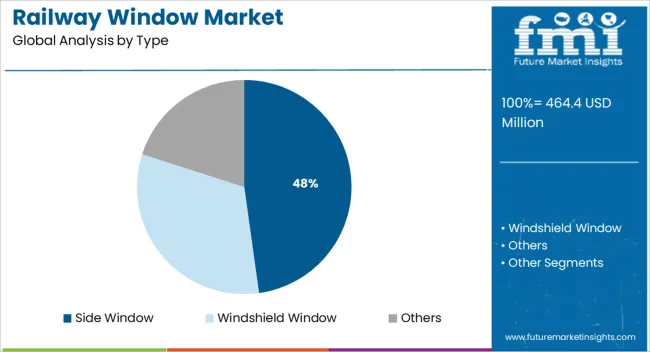
The side window segment is projected to account for 47.8% of the Railway Window market revenue share in 2025, making it the dominant type. This leadership is being influenced by the widespread installation of side windows in passenger coaches across regional, intercity, and high-speed trains. Side windows have been recognized for their role in improving visibility, ambient lighting, and passenger comfort, making them essential components in modern railcar design.
According to updates from rail coach manufacturers and product development briefings, side windows are being designed with enhanced materials that resist impact, reduce heat transfer, and support acoustic insulation. These benefits have led to their increasing preference in both new railcar production and refurbishment activities.
Their compatibility with various window technologies and integration flexibility across train types have also supported their large-scale adoption As demand rises for comfort-driven passenger environments, the side window segment is expected to maintain its strong position in the market.
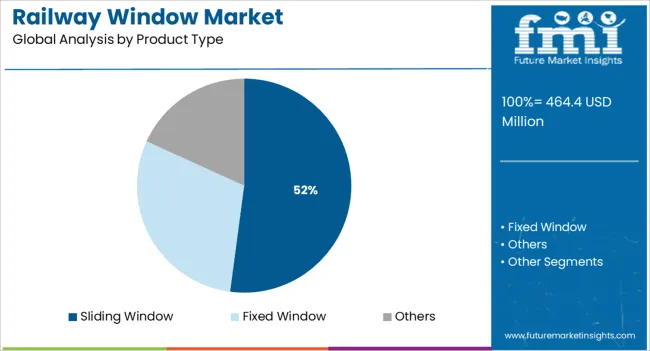
The sliding window segment is expected to hold 52.1% of the Railway Window market revenue share in 2025, emerging as the leading product type. This position is being driven by the practical functionality, ventilation support, and cost-effectiveness offered by sliding windows, especially in non-air-conditioned and commuter rail coaches.
Product specifications from rolling stock suppliers and design engineering updates have indicated that sliding windows are valued for their ease of operation, reduced mechanical complexity, and straightforward maintenance. Their adoption has remained strong in regions where natural ventilation is prioritized or where railway modernization programs are in transitional phases.
Furthermore, their adaptability to retrofitting and compatibility with existing carriage frames have made them a reliable option during fleet upgrades These characteristics, combined with procurement efficiencies and user-friendly operation, have reinforced the dominance of the sliding window segment in the overall market landscape.

The conventional railway windows segment is anticipated to capture 63.4% of the Railway Window market revenue share in 2025, leading the technology segment. This leadership is attributed to their established use across legacy rail systems and continued preference in cost-sensitive projects. Conventional designs have been favored by many national and regional railway authorities due to their proven durability, simple construction, and lower initial investment.
Industry communications and refurbishment program announcements have highlighted the widespread use of conventional windows in developing regions and older rolling stock fleets, where digital or smart window technologies are yet to be deployed. These systems often require minimal modification, allowing for straightforward replacement and maintenance procedures.
Additionally, their performance reliability under diverse climatic conditions has sustained their appeal in both passenger and utility coaches As cost-efficiency continues to play a critical role in rolling stock decisions, conventional railway windows are expected to remain widely implemented across several global markets.
According to previous records for the overall sales of railway windows in the global market, the valuation of total sales in the year 2020 was roughly USD 358.1 Million. the global railway window business saw considerable expansion before taking a devastating hit after the onset of the pandemic.
Despite a two-year dip in the demand for railway windows, the market's overall worth still reached USD 464.4 Million by the conclusion of 2025. During the time period from 2020 to 2025, the average year-on-year growth rate assessed by market statistics was almost 3.2%.
Also the growing requirement for mass transportation facilities in urban areas, government agencies are aiming to invest extensively in constructing metro railways. These expenditures would lead to fresh rolling stock orders invariably boosting the demand for railway windows during the forecast years. Furthermore, the growing need for interstate and intercity railway connections would present market participants with profitable potential in many countries.
Aside from that, in industrialized nations of Europe and the United States, previously manufactured railway rolling stocks are now old and require component upgrades and replacements. Such upgradation work of old rolling stocks is projected to create immense opportunities for higher sales of railway windows.
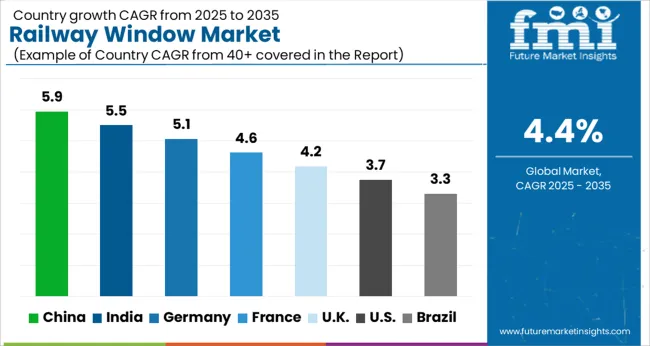
Sliding-side railway windows are predicted to be the quickly growing category over the next few years. Sliding or movable windows may allow commuters to ventilate the railcars and are very simple to install which has made them highly desirable in intercity trains.
However, the traditional or fixed railway window segment still holds the dominant share of the overall market. As modern railways are primarily deploying temperature-regulating railcars so fixed type windows are the appropriate choice for such trains. Moreover, the introduction of bullet trains and metro that prefer fixed glass windows are expected to increase the demand for this category with the passing of time.
The high-quality and innovative smart railway window category is likely to expand rapidly in terms of sales throughout the forecast period. When exposed to sunlight, smart glass windows change color from translucent to dark, reducing the quantity of daylight that penetrates the train compartment and maintaining a comfortable atmosphere.
Sales of railway windows for bullet trains are predicted to increase rapidly, depending on the train type. High-speed trains provide for speedier travel by utilizing high-speed rails and dedicated tracks so require specialized railway windows and other components.
Among all the industrialized economies the United States is the leading region for the global market of railway windows and contributes almost 18.3%. In accordance with the global railway window market survey report, the net worth of the market in the United States would exceed USD 714.4 Million by 2035.
By the virtue of the presence of many key market players and advanced technologies for the production of better products, the US is projected to remain the dominant market.
In the European Union, Germany is the leading market for the manufacturing and supply of all types of railway components. This country was figured out by the market survey report to have generated nearly USD 464.4 Million in the previous year 2025 which is around 4.7% of the global revenue.
On the other hand, the market for railway windows in the United Kingdom is witnessing a better growth rate than Germany and has attracted many global players recently. As per the market report, the UK is expected to witness a growth rate of 3.3% during the forecast years.
In European countries, there is a growing movement toward greener modes of transportation. Green mobility is permeating all forms of transport, including trains. This is expected to introduce the use of eco-friendly materials for the construction of all types of railway components. Moreover, the implications of reorganizing and revising rules to eliminate poor design are expected to give new growth prospects for the United Kingdom in the coming days.
The China railways windows market is expected to develop at a 3.7% annual growth rate until 2035. Extensive upgrades of railway window manufacturing facilities are expected to produce strong development indicators in this country.
Substantial governmental and private development expenditures are expected to boost the railway industry in this country. For example, the Chinese administration has spent around USD 148 Billion to build new metros in Baotou, Urumqi, and Xiamen.
Many other Asian countries, also including Japan, have made similar initiatives to strengthen their railway sector industries and export the products. Japan is also considered one of the leading manufacturers of railway windows which generated around USD 24 Million in revenue in the year 2025.
Given the huge population count and usage of public transportation in India, it is projected to be the fastest-growing market for railway windows and other components over the projection period. As per the railway window market report, India is anticipated to register the highest growth rate of 4.2% from 2025 to 2035.
Growing infrastructure and transportation development activity is expected to boost the regional railway window market even further. Also because India is a major global supplier of aluminum, the market participants in the country are gaining higher appeal in the global market.
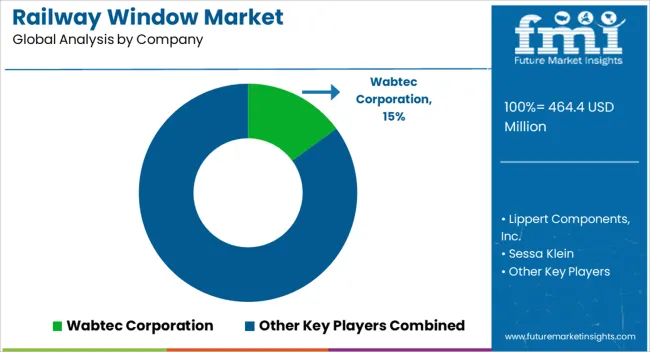
Rail service and related industries are capital-intensive and require significant resource support from local and national governments. For example, the building of Klang Valley Mass Rapid Transit Line 3 has been canceled since a significant expenditure has been invested in the establishment of MRT Lines 1 and 2. Such huge expenditures have resulted in the existence of very few railway component manufacturers making the overall market fairly consolidated.
Multiple railway window companies have engaged in Research and Development operations to create window panels in round or curved shapes. Any small or big change in dimensions for complicated curvatures and others requires a lot of expenditure in the development stage.
In order to demonstrate themselves as a reliable brand in such a concentrated industry, new entrants may have to spend more on Research and Development for improved railway windows. The selection of proper metal plays a very decisive role in the success of any enterprise participating in the global railway components market. Aluminum windows are easy to maintain and lightweight making them highly desirable for the railway sector.
The growing emphasis on reducing the use of polymer materials has emerged as a major challenge for many traditional railway window manufacturers. Some key players have already put investments in the development of biodegradable and eco-friendly alternatives of polymers that can be used in the construction of railway windows.
Start-ups entering the market are at advantage in this respect as national governments are also favoring the use of sustainable substitutes in all sectors under their jurisdiction.
The global railway window market is estimated to be valued at USD 464.4 million in 2025.
The market size for the railway window market is projected to reach USD 714.4 million by 2035.
The railway window market is expected to grow at a 4.4% CAGR between 2025 and 2035.
The key product types in railway window market are side window, windshield window and others.
In terms of product type, sliding window segment to command 52.1% share in the railway window market in 2025.






Full Research Suite comprises of:
Market outlook & trends analysis
Interviews & case studies
Strategic recommendations
Vendor profiles & capabilities analysis
5-year forecasts
8 regions and 60+ country-level data splits
Market segment data splits
12 months of continuous data updates
DELIVERED AS:
PDF EXCEL ONLINE
Railway Communication Equipment Market Size and Share Forecast Outlook 2025 to 2035
Railway Rolling Stock Market Forecast and Outlook 2025 to 2035
Railway System Market Size and Share Forecast Outlook 2025 to 2035
Railway Air Conditioning System Market Size and Share Forecast Outlook 2025 to 2035
Railway Braking System Market Size and Share Forecast Outlook 2025 to 2035
Railway CNC Wheel Lathe Market Size and Share Forecast Outlook 2025 to 2035
Railway Flatcar Market Size and Share Forecast Outlook 2025 to 2035
Railway Roof Switches Market Size and Share Forecast Outlook 2025 to 2035
Railway Maintenance Machinery Market Size and Share Forecast Outlook 2025 to 2035
Railway Control Stands Market Size and Share Forecast Outlook 2025 to 2035
Railway Horn Market Size and Share Forecast Outlook 2025 to 2035
Railway Axlebox Housing Market Analysis - Size, Share, and Forecast Outlook 2025 to 2035
Railway After-Cooler Market - Growth & Demand 2025 to 2035
Railway Air Filter Market – Growth & Demand 2025 to 2035
Railway Emergency Valves Market Trends and Forecast 2025 to 2035
Railway Draft Gears Market Growth – Trends & Forecast 2025 to 2035
Railway Generators Market Growth - Trends & Forecast 2025 to 2035
Railway Coupler Market Growth & Demand 2025 to 2035
Railway Fishplate Market Growth – Trends & Forecast 2025 to 2035
Railway Traction Motor Market Growth – Trends & Forecast 2025 to 2035

Thank you!
You will receive an email from our Business Development Manager. Please be sure to check your SPAM/JUNK folder too.
Chat With
MaRIA